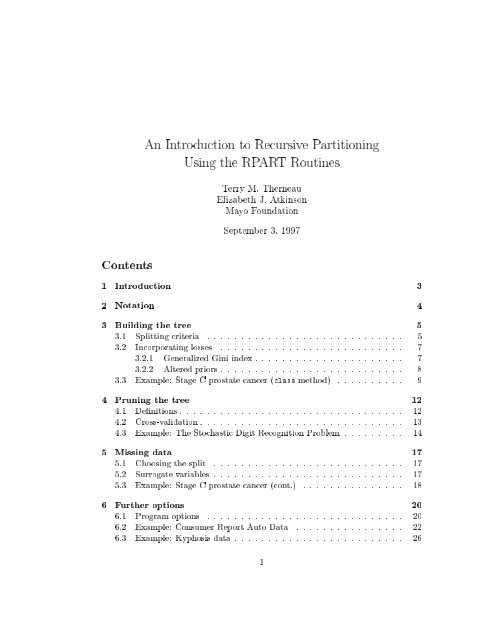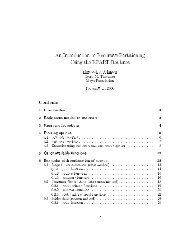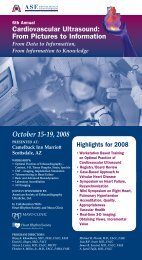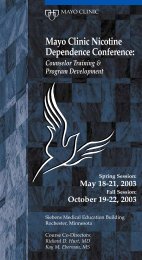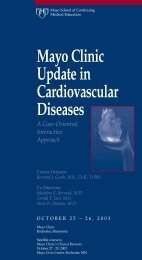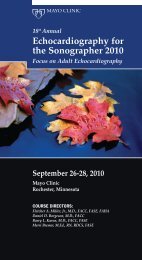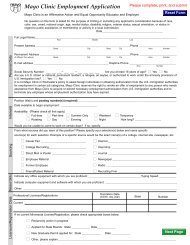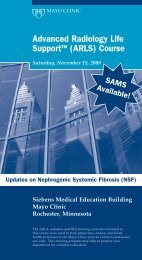An Introduction to Recursive Partitioning Using the ... - Mayo Clinic
An Introduction to Recursive Partitioning Using the ... - Mayo Clinic
An Introduction to Recursive Partitioning Using the ... - Mayo Clinic
You also want an ePaper? Increase the reach of your titles
YUMPU automatically turns print PDFs into web optimized ePapers that Google loves.
<strong>An</strong> <strong>Introduction</strong> <strong>to</strong> <strong>Recursive</strong> <strong>Partitioning</strong><br />
<strong>Using</strong> <strong>the</strong> RPART Routines<br />
Terry M. Therneau<br />
Elizabeth J. Atkinson<br />
<strong>Mayo</strong> Foundation<br />
September 3, 1997<br />
Contents<br />
1 <strong>Introduction</strong> 3<br />
2 Notation 4<br />
3 Building <strong>the</strong> tree 5<br />
3.1 Splitting criteria : : : : : : : : : : : : : : : : : : : : : : : : : : : : : 5<br />
3.2 Incorporating losses : : : : : : : : : : : : : : : : : : : : : : : : : : : 7<br />
3.2.1 Generalized Gini index : : : : : : : : : : : : : : : : : : : : : : 7<br />
3.2.2 Altered priors : : : : : : : : : : : : : : : : : : : : : : : : : : : 8<br />
3.3 Example: Stage C prostate cancer (class method) : : : : : : : : : : 9<br />
4 Pruning <strong>the</strong> tree 12<br />
4.1 Denitions : : : : : : : : : : : : : : : : : : : : : : : : : : : : : : : : : 12<br />
4.2 Cross-validation : : : : : : : : : : : : : : : : : : : : : : : : : : : : : : 13<br />
4.3 Example: The S<strong>to</strong>chastic Digit Recognition Problem : : : : : : : : : 14<br />
5 Missing data 17<br />
5.1 Choosing <strong>the</strong> split : : : : : : : : : : : : : : : : : : : : : : : : : : : : 17<br />
5.2 Surrogate variables : : : : : : : : : : : : : : : : : : : : : : : : : : : : 17<br />
5.3 Example: Stage C prostate cancer (cont.) : : : : : : : : : : : : : : : 18<br />
6 Fur<strong>the</strong>r options 20<br />
6.1 Program options : : : : : : : : : : : : : : : : : : : : : : : : : : : : : 20<br />
6.2 Example: Consumer Report Au<strong>to</strong> Data : : : : : : : : : : : : : : : : 22<br />
6.3 Example: Kyphosis data : : : : : : : : : : : : : : : : : : : : : : : : : 26<br />
1
7 Regression 28<br />
7.1 Denition : : : : : : : : : : : : : : : : : : : : : : : : : : : : : : : : : 28<br />
7.2 Example: Consumer Report Au<strong>to</strong> data (cont.) : : : : : : : : : : : : 29<br />
7.3 Example: Stage C prostate cancer (anova method) : : : : : : : : : : 33<br />
8 Poisson regression 35<br />
8.1 Denition : : : : : : : : : : : : : : : : : : : : : : : : : : : : : : : : : 35<br />
8.2 Improving <strong>the</strong> method : : : : : : : : : : : : : : : : : : : : : : : : : : 36<br />
8.3 Example: solder data : : : : : : : : : : : : : : : : : : : : : : : : : : : 37<br />
8.4 Example: Stage C prostate cancer (survival method) : : : : : : : : 41<br />
9 Plotting options 46<br />
10 O<strong>the</strong>r functions 49<br />
11 Relation <strong>to</strong> o<strong>the</strong>r programs 50<br />
11.1 CART : : : : : : : : : : : : : : : : : : : : : : : : : : : : : : : : : : : 50<br />
11.2 Tree : : : : : : : : : : : : : : : : : : : : : : : : : : : : : : : : : : : : 51<br />
12 Source 52<br />
2
24 patients revived / 144 not revived<br />
H<br />
HHHHHHHH<br />
<br />
<br />
<br />
<br />
<br />
<br />
<br />
<br />
X 1 =1<br />
22 / 13<br />
H HHHH<br />
<br />
<br />
X 1 =2, 3 or 4<br />
2 / 131<br />
H HHHH<br />
<br />
<br />
X 2 =1<br />
20/5<br />
X 2 =2 or 3<br />
2/8<br />
X 3 =1<br />
2/31<br />
X 3 =2 or 3<br />
0 / 100<br />
Figure 1: Revival data<br />
1 <strong>Introduction</strong><br />
This document is an update of a technical report written several years ago at Stanford<br />
[5], and is intended <strong>to</strong> give a short overview of <strong>the</strong> methods found in <strong>the</strong> rpart<br />
routines, which implement many of <strong>the</strong> ideas found in <strong>the</strong> CART (Classication and<br />
Regression Trees) book and programs of Breiman, Friedman, Olshen and S<strong>to</strong>ne [1].<br />
Because CART is <strong>the</strong> trademarked name of a particular software implementation of<br />
<strong>the</strong>se ideas, and tree has been used for <strong>the</strong> S-plus routines of Clark and Pregibon[2]<br />
a dierent acronym | <strong>Recursive</strong> PARTitioning or rpart | was chosen.<br />
The rpart programs build classication or regression models of a very general<br />
structure using a two stage procedure; <strong>the</strong> resulting models can be represented as<br />
binary trees. <strong>An</strong> example is some preliminary data ga<strong>the</strong>red at Stanford on revival<br />
of cardiac arrest patients by paramedics. The goal is <strong>to</strong> predict which patients<br />
are revivable in <strong>the</strong> eld on <strong>the</strong> basis of fourteen variables known at or near <strong>the</strong><br />
time of paramedic arrival, e.g., sex, age, time from arrest <strong>to</strong> rst care, etc. Since<br />
some patients who are not revived on site are later successfully resuscitated at <strong>the</strong><br />
hospital, early identication of <strong>the</strong>se \recalcitrant" cases is of considerable clinical<br />
interest.<br />
The resultant model separated <strong>the</strong> patients in<strong>to</strong> four groups as shown in gure<br />
1, where<br />
X 1 = initial heart rhythm<br />
1= VF/VT, 2=EMD, 3=Asys<strong>to</strong>le, 4=O<strong>the</strong>r<br />
X 2 = initial response <strong>to</strong> debrillation<br />
3
1=Improved, 2=No change, 3=Worse<br />
X 3 = initial response <strong>to</strong> drugs<br />
1=Improved, 2=No change, 3=Worse<br />
The o<strong>the</strong>r 11 variables did not appear in <strong>the</strong> nal model. This procedure seems<br />
<strong>to</strong> work especially well for variables such asX 1 , where <strong>the</strong>re is a denite ordering,<br />
but spacings are not necessarily equal.<br />
The tree is built by <strong>the</strong> following process: rst <strong>the</strong> single variable is found which<br />
best splits <strong>the</strong> data in<strong>to</strong> two groups (`best' will be dened later). The data is<br />
separated, and <strong>the</strong>n this process is applied separately <strong>to</strong> each sub-group, and so on<br />
recursively until <strong>the</strong> subgroups ei<strong>the</strong>r reach a minimum size (5 for this data) or until<br />
no improvement can be made.<br />
The resultant model is, with certainty, <strong>to</strong>o complex, and <strong>the</strong> question arises as it<br />
does with all stepwise procedures of when <strong>to</strong> s<strong>to</strong>p. The second stage of <strong>the</strong> procedure<br />
consists of using cross-validation <strong>to</strong> trim back <strong>the</strong> full tree. In <strong>the</strong> medical example<br />
above <strong>the</strong> full tree had ten terminal regions. A cross validated estimate of risk was<br />
computed for a nested set of subtrees; this nal model, presented in gure 1, is <strong>the</strong><br />
subtree with <strong>the</strong> lowest estimate of risk.<br />
2 Notation<br />
The partitioning method can be applied <strong>to</strong> many dierent kinds of data. We will<br />
start by looking at <strong>the</strong> classication problem, which isoneof <strong>the</strong> more instructive<br />
cases (but also has <strong>the</strong> most complex equations). The sample population consists<br />
of n observations from C classes. A given model will break <strong>the</strong>se observations in<strong>to</strong><br />
k terminal groups; <strong>to</strong> each of <strong>the</strong>se groups is assigned a predicted class (this will be<br />
<strong>the</strong> response variable). In an actual application, most parameters will be estimated<br />
from <strong>the</strong> data, such estimates are given by formulae.<br />
i i =1; 2; :::; C Prior probabilities of each class.<br />
L(i; j) i =1; 2; :::; C Loss matrix for incorrectly classifying<br />
an i as a j. L(i; i) 0:<br />
A<br />
Some node of <strong>the</strong> tree.<br />
Note that A represents both a set of individuals in<br />
<strong>the</strong> sample data, and, via <strong>the</strong> tree that produced it,<br />
a classication rule for future data.<br />
4
(x)<br />
(A)<br />
True class of an observation x, where x is <strong>the</strong><br />
vec<strong>to</strong>r of predic<strong>to</strong>r variables.<br />
The class assigned <strong>to</strong> A, if A were <strong>to</strong> be taken as a<br />
nal node.<br />
n i ;n A Number of observations in <strong>the</strong> sample that are class i,<br />
number of obs in node A.<br />
n iA Number of observations in <strong>the</strong> sample that are class i and node A.<br />
P (A)<br />
p(ijA)<br />
R(A)<br />
R(T )<br />
Probability ofA (for future observations).<br />
= P C<br />
i=1<br />
i P fx 2 A j (x) =ig<br />
P C<br />
i=1<br />
i n iA =n i )<br />
P f(x) =i j x 2 Ag (for future observations)<br />
= i P fx 2 A j (x) =ig=P fx 2 Ag<br />
i (n iA =n i )= P i (n iA =n i<br />
Risk of A<br />
= P C<br />
i=1<br />
p(ijA)L(i; (A))<br />
where (A) ischosen <strong>to</strong> minimize this risk.<br />
Risk of a model (or tree) T<br />
= P k<br />
j=1<br />
P (A j )R(A j )<br />
where A j are <strong>the</strong> terminal nodes of <strong>the</strong> tree.<br />
If L(i; j) = 1 for all i 6= j, and we set <strong>the</strong> prior probabilities equal <strong>to</strong> <strong>the</strong><br />
observed class frequencies in <strong>the</strong> sample <strong>the</strong>n p(ijA) = n iA =n A and R(T ) is <strong>the</strong><br />
proportion misclassied.<br />
3 Building <strong>the</strong> tree<br />
3.1 Splitting criteria<br />
If we split a node A in<strong>to</strong> two sons A L and A R (left and right sons), we will have<br />
P (A L )R(A L )+P (A R )R(A R ) P (A)R(A)<br />
5
(this is proven in [1]). <strong>Using</strong> this, one obvious way <strong>to</strong> build a tree is <strong>to</strong> choose<br />
that split which maximizes R, <strong>the</strong> decrease in risk. There are defects with this,<br />
however, as <strong>the</strong> following example shows.<br />
Suppose losses are equal and that <strong>the</strong> data is 80% class 1's, and that<br />
some trial split results in A L being 54% class 1's and A R being 100%<br />
class 1's. Class 1's versus class 0's are <strong>the</strong> outcome variable in this<br />
example. Since <strong>the</strong> minimum risk prediction for both <strong>the</strong> left and right<br />
son is (A L )=(A R ) = 1, this split will have R =0,yet scientically<br />
this is a very informative division of <strong>the</strong> sample. In real data with such<br />
a majority, <strong>the</strong> rst few splits very often can do no better than this.<br />
A more serious defect with maximizing R is that <strong>the</strong> risk reduction is essentially<br />
linear. If <strong>the</strong>re were two competing splits, one separating <strong>the</strong> data in<strong>to</strong> groups of<br />
85% and 50% purity respectively, and <strong>the</strong> o<strong>the</strong>r in<strong>to</strong> 70%-70%, we would usually<br />
prefer <strong>the</strong> former, if for no o<strong>the</strong>r reason than because it better sets things up for <strong>the</strong><br />
next splits.<br />
One way around both of <strong>the</strong>se problems is <strong>to</strong> use lookahead rules; but <strong>the</strong>se<br />
are computationally very expensive. Instead rpart uses one of several measures of<br />
impurity, or diversity, of a node. Let f be some impurity function and dene <strong>the</strong><br />
impurity ofanodeAas<br />
I(A) =<br />
CX<br />
i=1<br />
f(p iA )<br />
where p iA is <strong>the</strong> proportion of those in A that belong <strong>to</strong> class i for future samples.<br />
Since we would like I(A) =0 when A is pure, f must be concave with f(0) = f(1) =<br />
0.<br />
Two candidates for f are <strong>the</strong> information index f(p) =,p log(p) and <strong>the</strong> Gini<br />
index f(p) =p(1 , p). We <strong>the</strong>n use that split with maximal impurity reduction<br />
I = p(A)I(A) , p(A L )I(A L ) , p(A R )I(A R )<br />
The two impurity functions are plotted in gure (2), with <strong>the</strong> second plot scaled<br />
so that <strong>the</strong> maximum for both measures is at 1. For <strong>the</strong> two class problem <strong>the</strong><br />
measures dier only slightly, and will nearly always choose <strong>the</strong> same split point.<br />
<strong>An</strong>o<strong>the</strong>r convex criteria not quite of <strong>the</strong> above class is twoing for which<br />
I(A) =min<br />
C 1 C 2<br />
[f(p C1 )+f(p C2 )]<br />
where C 1 ,C 2 is some partition of <strong>the</strong> C classes in<strong>to</strong> two disjoint sets. If C =2twoing<br />
is equivalent <strong>to</strong> <strong>the</strong> usual impurity index for f. Surprisingly,twoing can be calculated<br />
almost as eciently as <strong>the</strong> usual impurity index. One potential advantage of twoing<br />
6
Impurity<br />
0.0 0.2 0.4 0.6<br />
Gini criteria<br />
Information<br />
Scaled Impurity<br />
0.0 0.2 0.4 0.6 0.8 1.0<br />
Gini criteria<br />
Information<br />
0.0 0.2 0.4 0.6 0.8 1.0<br />
0.0 0.2 0.4 0.6 0.8 1.0<br />
P<br />
P<br />
Figure 2: Comparison of Gini and Information indices<br />
is that <strong>the</strong> output may give <strong>the</strong> user additional insight concerning <strong>the</strong> structure of<br />
<strong>the</strong> data. It can be viewed as <strong>the</strong> partition of C in<strong>to</strong> two superclasses which are in<br />
some sense <strong>the</strong> most dissimilar for those observations in A. For certain problems<br />
<strong>the</strong>re may be a natural ordering of <strong>the</strong> response categories (e.g. level of education),<br />
in which case ordered twoing can be naturally dened, by restricting C 1 <strong>to</strong> be an<br />
interval [1; 2;:::;k] of classes. Twoing is not part of rpart.<br />
3.2 Incorporating losses<br />
One saluta<strong>to</strong>ry aspect of <strong>the</strong> risk reduction criteria not found in <strong>the</strong> impurity measures<br />
is inclusion of <strong>the</strong> loss function. Two dierent ways of extending <strong>the</strong> impurity<br />
criteria <strong>to</strong> also include losses are implemented in CART, <strong>the</strong> generalized Gini index<br />
and altered priors. The rpart software implements only <strong>the</strong> altered priors method.<br />
3.2.1 Generalized Gini index<br />
The Gini index has <strong>the</strong> following interesting interpretation. Suppose an object is<br />
selected at random from one of C classes according <strong>to</strong> <strong>the</strong> probabilities (p 1 ;p 2 ; :::; p C )<br />
and is randomly assigned <strong>to</strong> a class using <strong>the</strong> same distribution. The probability of<br />
7
misclassication is<br />
XX<br />
i<br />
j6=i<br />
p i p j = X i<br />
X<br />
j<br />
p i p j , X i<br />
p 2 i = X i<br />
1 , p 2 i<br />
= Gini index for p<br />
Let L(i; j) be <strong>the</strong> loss of assigning class j <strong>to</strong> an object which actually belongs <strong>to</strong> class<br />
i. The expected cost of misclassication is PP L(i; j)p i p j . This suggests dening<br />
a generalized Gini index of impurity by<br />
G(p) = X i<br />
X<br />
j<br />
L(i; j)p i p j<br />
The corresponding splitting criterion appears <strong>to</strong> be promising for applications<br />
involving variable misclassication costs. But <strong>the</strong>re are several reasonable objections<br />
<strong>to</strong> it. First, G(p) is not necessarily a concave function of p, whichwas <strong>the</strong> motivating<br />
fac<strong>to</strong>r behind impurity measures. More seriously, G symmetrizes <strong>the</strong> loss matrix<br />
before using it. To see this note that<br />
G(p) =(1=2) XX [L(i; j)+L(j; i)] p i p j<br />
In particular, for two-class problems, G in eect ignores <strong>the</strong> loss matrix.<br />
3.2.2 Altered priors<br />
Remember <strong>the</strong> denition of R(A)<br />
R(A)<br />
<br />
=<br />
CX<br />
i=1<br />
CX<br />
i=1<br />
p iA L(i; (A))<br />
Assume <strong>the</strong>re exists ~ and ~ L be such that<br />
i L(i; (A))(n iA =n i )(n=n A )<br />
~ i<br />
~ L(i; j) =i L(i; j) 8i; j 2 C<br />
Then R(A) is unchanged under <strong>the</strong> new losses and priors. If L ~ is proportional <strong>to</strong><br />
<strong>the</strong> zero-one loss matrix <strong>the</strong>n <strong>the</strong> priors ~ should be used in <strong>the</strong> splitting criteria.<br />
This is possible only if L is of <strong>the</strong> form<br />
(<br />
Li i 6= j<br />
L(i; j) =<br />
0 i = j<br />
8
in which case<br />
~ i = iL<br />
P i<br />
j jL j<br />
This is always possible when C =2,and hence altered priors are exact for <strong>the</strong> two<br />
class problem. For P arbitrary loss matrix of dimension C > 2, rpart uses <strong>the</strong> above<br />
formula with L i = j L(i; j).<br />
A second justication for altered priors is this. <strong>An</strong> impurity index I(A) =<br />
P f(pi ) has its maximum at p 1 = p 2 = ::: = p C = 1=C. If a problem had, for<br />
instance, a misclassication loss for class 1 which was twice <strong>the</strong> loss for a class 2 or<br />
3 observation, one would wish I(A) <strong>to</strong> have its maximum at p 1 =1/5, p 2 = p 3 =2/5,<br />
since this is <strong>the</strong> worst possible set of proportions on which <strong>to</strong> decide a node's class.<br />
The altered priors technique does exactly this, by shifting <strong>the</strong> p i .<br />
Two nal notes<br />
When altered priors are used, <strong>the</strong>y aect only <strong>the</strong> choice of split. The ordinary<br />
losses and priors are used <strong>to</strong> compute <strong>the</strong> risk of <strong>the</strong> node. The altered priors<br />
simply help <strong>the</strong> impurity rule choose splits that are likely <strong>to</strong> be \good" in<br />
terms of <strong>the</strong> risk.<br />
The argument for altered priors is valid for both <strong>the</strong> gini and information<br />
splitting rules.<br />
3.3 Example: Stage C prostate cancer (class method)<br />
This rst example is based on a data set of 146 stage C prostate cancer patients<br />
[4]. The main clinical endpoint ofinterest is whe<strong>the</strong>r <strong>the</strong> disease recurs after initial<br />
surgical removal of <strong>the</strong> prostate, and <strong>the</strong> time interval <strong>to</strong> that progression (if any).<br />
The endpoint in this example is status, which takes on <strong>the</strong> value 1 if <strong>the</strong> disease has<br />
progressed and 0 if not. Later we'll analyze <strong>the</strong> data using <strong>the</strong> exponential (exp)<br />
method, which will take in<strong>to</strong> account time <strong>to</strong> progression. A short description of<br />
each of <strong>the</strong> variables is listed below. The main predic<strong>to</strong>r variable of interest in this<br />
study was DNA ploidy, as determined by ow cy<strong>to</strong>metry. For diploid and tetraploid<br />
tumors, <strong>the</strong> ow cy<strong>to</strong>metric method was also able <strong>to</strong> estimate <strong>the</strong> percent of tumor<br />
cells in a G 2 (growth) stage of <strong>the</strong>ir cell cycle; G 2 % is systematically missing for<br />
most aneuploid tumors.<br />
The variables in <strong>the</strong> data set are<br />
9
grade11.845<br />
g262.5<br />
Prog<br />
Prog<br />
Figure 3: Classication tree for <strong>the</strong> Stage C data<br />
pgtime time <strong>to</strong> progression, or last follow-up free of progression<br />
pgstat status at last follow-up (1=progressed, 0=censored)<br />
age age at diagnosis<br />
eet early endocrine <strong>the</strong>rapy (1=no, 0=yes)<br />
ploidy diploid/tetraploid/aneuploid DNA pattern<br />
g2 % of cells in G 2 phase<br />
grade tumor grade (1-4)<br />
gleason Gleason grade (3-10)<br />
The model is t by using <strong>the</strong> rpart function. The rst argument of <strong>the</strong> function<br />
is a model formula, with <strong>the</strong> symbol standing for \is modeled as". The print<br />
function gives an abbreviated output, as for o<strong>the</strong>r S models. The plot and text<br />
command plot <strong>the</strong> tree and <strong>the</strong>n label <strong>the</strong> plot, <strong>the</strong> result is shown in gure 3.<br />
> progstat cfit print(cfit)<br />
node), split, n, loss, yval, (yprob)<br />
* denotes terminal node<br />
1) root 146 54 No ( 0.6301 0.3699 )<br />
10
2) grade2.5 85 40 Prog ( 0.4706 0.5294 )<br />
6) g211.845 7 1 No ( 0.8571 0.1429 ) *<br />
25) g213.2 45 17 Prog ( 0.3778 0.6222 )<br />
14) g2>17.91 22 8 No ( 0.6364 0.3636 )<br />
28) age>62.5 15 4 No ( 0.7333 0.2667 ) *<br />
29) age text(cfit)<br />
The creation of a labeled fac<strong>to</strong>r variable as <strong>the</strong> response improves <strong>the</strong> labeling<br />
of <strong>the</strong> prin<strong>to</strong>ut.<br />
We have explicitly directed <strong>the</strong> routine <strong>to</strong> treat progstat as a categorical variable<br />
by asking for method='class'. (Since progstat is a fac<strong>to</strong>r this would have<br />
been <strong>the</strong> default choice). Since no optional classication parameters are specied<br />
<strong>the</strong> routine will use <strong>the</strong> Gini rule for splitting, prior probabilities that are<br />
proportional <strong>to</strong> <strong>the</strong> observed data frequencies, and 0/1 losses.<br />
The child nodes of node x are always numbered 2x (left) and 2x +1 (right),<br />
<strong>to</strong> help in navigating <strong>the</strong> prin<strong>to</strong>ut (compare <strong>the</strong> prin<strong>to</strong>ut <strong>to</strong> gure 3).<br />
O<strong>the</strong>r items in <strong>the</strong> list are <strong>the</strong> denition of <strong>the</strong> variable and split used <strong>to</strong> create<br />
a node, <strong>the</strong> number of subjects at <strong>the</strong> node, <strong>the</strong> loss or error at <strong>the</strong> node (for<br />
this example, with proportional priors and unit losses this will be <strong>the</strong> number<br />
misclassied), <strong>the</strong> classication of <strong>the</strong> node, and <strong>the</strong> predicted class for <strong>the</strong><br />
node.<br />
* indicates that <strong>the</strong> node is terminal.<br />
Grades 1 and 2 go <strong>to</strong> <strong>the</strong> left, grades 3 and 4 go <strong>to</strong> <strong>the</strong> right. The tree is<br />
arranged so that <strong>the</strong> branches with <strong>the</strong> largest \average class" go <strong>to</strong> <strong>the</strong> right.<br />
11
4 Pruning <strong>the</strong> tree<br />
4.1 Denitions<br />
We have built a complete tree, possibly quite large and/or complex, and must now<br />
decide how much of that model <strong>to</strong> retain. In forward stepwise regression, for instance,<br />
this issue is addressed sequentially and no additional variables are added<br />
when <strong>the</strong> F-test for <strong>the</strong> remaining variables fails <strong>to</strong> achieve some level .<br />
Let T 1 , T 2 ,....,T k be <strong>the</strong> terminal nodes of a tree T. Dene<br />
jT j =number of terminal nodes<br />
risk of T = R(T )= P k<br />
i=1<br />
P (T i )R(T i )<br />
In comparison <strong>to</strong> regression, jT j is analogous <strong>to</strong> <strong>the</strong> model degrees of freedom and<br />
R(T ) <strong>to</strong> <strong>the</strong> residual sum of squares.<br />
Now let be some number between 0 and 1 which measures <strong>the</strong> 'cost' of adding<br />
ano<strong>the</strong>r variable <strong>to</strong> <strong>the</strong> model; will be called a complexity parameter. Let R(T 0 )<br />
be <strong>the</strong> risk for <strong>the</strong> zero split tree. Dene<br />
R (T )=R(T )+jT j<br />
<strong>to</strong> be <strong>the</strong> cost for <strong>the</strong> tree, and dene T <strong>to</strong> be that subtree of <strong>the</strong> full model which<br />
has minimal cost. Obviously T 0 = <strong>the</strong> full model and T1 = <strong>the</strong> model with no splits<br />
at all. The following results are shown in [1].<br />
1. If T 1 and T 2 are subtrees of T with R (T 1 ) = R (T 2 ), <strong>the</strong>n ei<strong>the</strong>r T 1 is a<br />
subtree of T 2 or T 2 is a subtree of T 1 ; hence ei<strong>the</strong>r jT 1 j < jT 2 j or jT 2 j < jT 1 j.<br />
2. If ><strong>the</strong>n ei<strong>the</strong>r T = T or T is a strict subtree of T .<br />
3. Given some set of numbers 1 ; 2 ;:::; m ; both T 1 ;:::;T m and R(T 1 ), :::,<br />
R(T m ) can be computed eciently.<br />
<strong>Using</strong> <strong>the</strong> rst result, we can uniquely dene T as <strong>the</strong> smallest tree T for which<br />
R (T ) is minimized.<br />
Since any sequence of nested trees based on T has at most jT j members, result<br />
2 implies that all possible values of can be grouped in<strong>to</strong> m intervals, m jT j<br />
I 1 = [0; 1 ]<br />
I 2 = ( 1 ; 2 ]<br />
.<br />
I m = ( m,1; 1]<br />
where all 2 I i share <strong>the</strong> same minimizing subtree.<br />
12
4.2 Cross-validation<br />
Cross-validation is used <strong>to</strong> choose a best value for by <strong>the</strong> following steps:<br />
1. Fit <strong>the</strong> full model on <strong>the</strong> data set<br />
compute I 1 ;I 2 ; :::; I m<br />
set 1 =0<br />
2 = p 1 2<br />
3 = p 2 3<br />
.<br />
m,1 = p m,2 m,1<br />
m = 1<br />
each i is a `typical value' for its I i<br />
2. Divide <strong>the</strong> data set in<strong>to</strong> s groups G 1 ;G 2 ; :::; G s each of size s=n, and for each<br />
group separately:<br />
t a full model on <strong>the</strong> data set `everyone except G i ' and determine<br />
T 1 ;T 2 ; :::; T m for this reduced data set,<br />
compute <strong>the</strong> predicted class for each observation in G i , under each of<strong>the</strong><br />
models T j for 1 j m,<br />
from this compute <strong>the</strong> risk for each subject.<br />
3. Sum over <strong>the</strong> G i <strong>to</strong> get an estimate of risk for each j . For that (complexity<br />
parameter) with smallest risk compute T for <strong>the</strong> full data set, this is chosen<br />
as <strong>the</strong> best trimmed tree.<br />
In actual practice, we may use instead <strong>the</strong> 1-SE rule. A plot of versus risk often<br />
has an initial sharp drop followed by arelatively at plateau and <strong>the</strong>n a slow rise.<br />
The choice of among those models on <strong>the</strong> plateau can be essentially random. To<br />
avoid this, both an estimate of <strong>the</strong> risk and its standard error are computed during<br />
<strong>the</strong> cross-validation. <strong>An</strong>y risk within one standard error of <strong>the</strong> achieved minimum<br />
is marked as being equivalent <strong>to</strong> <strong>the</strong> minimum (i.e. considered <strong>to</strong> be part of <strong>the</strong><br />
at plateau). Then <strong>the</strong> simplest model, among all those \tied" on <strong>the</strong> plateau, is<br />
chosen.<br />
In <strong>the</strong> usual denition of cross-validation we would have taken s = n above, i.e.,<br />
each of <strong>the</strong> G i would contain exactly one observation, but for moderate n this is<br />
computationally prohibitive. Avalue of s = 10 has been found <strong>to</strong> be sucient, but<br />
users can vary this if <strong>the</strong>y wish.<br />
In Monte-Carlo trials, this method of pruning has proven very reliable for screening<br />
out `pure noise' variables in <strong>the</strong> data set.<br />
13
4.3 Example: The S<strong>to</strong>chastic Digit Recognition Problem<br />
This example is found in section 2.6 of [1], and used as a running example throughout<br />
much of <strong>the</strong>ir book. Consider <strong>the</strong> segments of an unreliable digital readout<br />
1<br />
2 3<br />
4<br />
5<br />
6<br />
7<br />
where each light is correct with probability 0.9, e.g., if <strong>the</strong> true digit is a 2, <strong>the</strong> lights<br />
1, 3, 4, 5, and 7 are on with probability 0.9 and lights 2 and 6 are on with probability<br />
0.1. Construct test data where Y 2f0; 1; :::; 9g, each with proportion 1/10 and<br />
<strong>the</strong> X i , i =1;:::;7 are i.i.d. Bernoulli variables with parameter depending on Y.<br />
X 8 ,X 24 are generated as i.i.d bernoulli P fX i =1g = :5, and are independent ofY.<br />
They correspond <strong>to</strong> imbedding <strong>the</strong> readout in a larger rectangle of random lights.<br />
A sample of size 200 was generated accordingly and <strong>the</strong> procedure applied using<br />
<strong>the</strong> gini index (see 3.2.1) <strong>to</strong> build <strong>the</strong> tree. The S-plus code <strong>to</strong> compute <strong>the</strong> simulated<br />
data and <strong>the</strong> t are shown below.<br />
> n temp lights temp1 temp1 temp2 x
x.7>0.5<br />
|<br />
x.3>0.5<br />
x.4
5 0.0555556 8 0.36111 0.56111 0.0392817<br />
6 0.0166667 9 0.30556 0.36111 0.0367990<br />
7 0.0111111 11 0.27222 0.37778 0.0372181<br />
8 0.0083333 12 0.26111 0.36111 0.0367990<br />
9 0.0055556 16 0.22778 0.35556 0.0366498<br />
10 0.0027778 27 0.16667 0.34444 0.0363369<br />
11 0.0013889 31 0.15556 0.36667 0.0369434<br />
12 0.0000000 35 0.15000 0.36667 0.0369434<br />
> fit9 plot(fit9, branch=.3, compress=T)<br />
> text(fit9)<br />
The cp table diers from that in section 3.5 of [1] in several ways, <strong>the</strong> last two<br />
of which are somewhat important.<br />
The actual values are dierent, of course, because of dierent random number<br />
genera<strong>to</strong>rs in <strong>the</strong> two runs.<br />
The table is printed from <strong>the</strong> smallest tree (no splits) <strong>to</strong> <strong>the</strong> largest one (35<br />
splits). We nd it easier <strong>to</strong> compare one tree <strong>to</strong> ano<strong>the</strong>r when <strong>the</strong>y start at<br />
<strong>the</strong> same place.<br />
The number of splits is listed, ra<strong>the</strong>r than <strong>the</strong> number of nodes. The number<br />
of nodes is always 1 + <strong>the</strong> number of splits.<br />
For easier reading, <strong>the</strong> error columns have been scaled so that <strong>the</strong> rst node<br />
has an error of 1. Since in this example <strong>the</strong> model with no splits must make<br />
180/200 misclassications, multiply columns 3-5 by 180 <strong>to</strong> get a result in<br />
terms of absolute error. (Computations are done on <strong>the</strong> absolute error scale,<br />
and printed on relative scale).<br />
The complexity parameter column (cp) has been similarly scaled.<br />
Looking at <strong>the</strong> cp table, we see that <strong>the</strong> best tree has 10 terminal nodes (9 splits),<br />
based on cross-validation (using 1-SE rule of 0:3444 + 0:0363369). This subtree is<br />
extracted with call <strong>to</strong> prune and saved in fit9. The pruned tree is shown in gure<br />
4. Two options have been used in <strong>the</strong> plot. The compress option tries <strong>to</strong> narrow <strong>the</strong><br />
prin<strong>to</strong>ut by vertically overlapping portions of <strong>the</strong> plot. (It has only a small eect on<br />
this particular dendrogram). The branch option controls <strong>the</strong> shape of <strong>the</strong> branches<br />
that connect a node <strong>to</strong> its children. The section on plotting (9) will discuss this and<br />
o<strong>the</strong>r options in more detail.<br />
The largest tree, with 36 terminal nodes, correctly classies 170/200 = 85%<br />
(1 , 0:15) of <strong>the</strong> observations, but uses several of <strong>the</strong> random predic<strong>to</strong>rs in doing<br />
16
so and seriously overts <strong>the</strong> data. If <strong>the</strong> number of observations per terminal node<br />
(minbucket) had been set <strong>to</strong> 1 instead of 2, <strong>the</strong>n every observation would be classied<br />
correctly in <strong>the</strong> nal model, many in terminal nodes of size 1.<br />
5 Missing data<br />
5.1 Choosing <strong>the</strong> split<br />
Missing values are one of <strong>the</strong> curses of statistical models and analysis. Most procedures<br />
deal with <strong>the</strong>m by refusing <strong>to</strong> deal with <strong>the</strong>m { incomplete observations are<br />
<strong>to</strong>ssed out. Rpart is somewhat more ambitious. <strong>An</strong>y observation with values for<br />
<strong>the</strong> dependent variable and at least one independent variable will participate in <strong>the</strong><br />
modeling.<br />
The quantity <strong>to</strong> be maximized is still<br />
I = p(A)I(A) , p(A L )I(A L ) , p(A R )I(A R )<br />
The leading term is <strong>the</strong> same for all variables and splits irrespective of missing<br />
data, but <strong>the</strong> right two terms are somewhat modied. Firstly, <strong>the</strong> impurity indices<br />
I(A R ) and I(A L ) are calculated only over <strong>the</strong> observations which are not missing<br />
a particular predic<strong>to</strong>r. Secondly, <strong>the</strong> two probabilities p(A L ) and p(A R ) are also<br />
calculated only over <strong>the</strong> relevant observations, but <strong>the</strong>y are <strong>the</strong>n adjusted so that<br />
<strong>the</strong>y sum <strong>to</strong> p(A). This entails some extra bookkeeping as <strong>the</strong> tree is built, but<br />
ensures that <strong>the</strong> terminal node probabilities sum <strong>to</strong> 1.<br />
In <strong>the</strong> extreme case of a variable for which only 2 observations are non-missing,<br />
<strong>the</strong> impurity of <strong>the</strong> two sons will both be zero when splitting on that variable. Hence<br />
I will be maximal, and this `almost all missing' coordinate is guaranteed <strong>to</strong> be<br />
chosen as best; <strong>the</strong> method is certainly awed in this extreme case. It is dicult <strong>to</strong><br />
say whe<strong>the</strong>r this bias <strong>to</strong>ward missing coordinates carries through <strong>to</strong> <strong>the</strong> non-extreme<br />
cases, however, since a more complete variable also aords for itself more possible<br />
values at which <strong>to</strong> split.<br />
5.2 Surrogate variables<br />
Once a splitting variable and a split point for it have been decided, what is <strong>to</strong><br />
be done with observations missing that variable? One approach is <strong>to</strong> estimate <strong>the</strong><br />
missing datum using <strong>the</strong> o<strong>the</strong>r independent variables; rpart uses a variation of this<br />
<strong>to</strong> dene surrogate variables.<br />
As an example, assume that <strong>the</strong> split (age
ecursion) <strong>to</strong> predict <strong>the</strong> two categories `age printcp(fit)<br />
Classification tree:<br />
rpart(formula = progstat ~ age + eet + g2 + grade + gleason + ploidy,<br />
data = stagec)<br />
18
Variables actually used in tree construction:<br />
[1] age g2 grade ploidy<br />
Root node error: 54/146 = 0.36986<br />
CP nsplit rel error xerror xstd<br />
1 0.104938 0 1.00000 1.0000 0.10802<br />
2 0.055556 3 0.68519 1.1852 0.11103<br />
3 0.027778 4 0.62963 1.0556 0.10916<br />
4 0.018519 6 0.57407 1.0556 0.10916<br />
5 0.010000 7 0.55556 1.0556 0.10916<br />
> summary(cfit,cp=.06)<br />
Node number 1: 146 observations, complexity param=0.1049<br />
predicted class= No expected loss= 0.3699<br />
class counts: 92 54<br />
probabilities: 0.6301 0.3699<br />
left son=2 (61 obs) right son=3 (85 obs)<br />
Primary splits:<br />
grade < 2.5 <strong>to</strong> <strong>the</strong> left, improve=10.360, (0 missing)<br />
gleason < 5.5 <strong>to</strong> <strong>the</strong> left, improve= 8.400, (3 missing)<br />
ploidy splits as LRR, improve= 7.657, (0 missing)<br />
g2 < 13.2 <strong>to</strong> <strong>the</strong> left, improve= 7.187, (7 missing)<br />
age < 58.5 <strong>to</strong> <strong>the</strong> right, improve= 1.388, (0 missing)<br />
Surrogate splits:<br />
gleason < 5.5 <strong>to</strong> <strong>the</strong> left, agree=0.8630, (0 split)<br />
ploidy splits as LRR, agree=0.6438, (0 split)<br />
g2 < 9.945 <strong>to</strong> <strong>the</strong> left, agree=0.6301, (0 split)<br />
age < 66.5 <strong>to</strong> <strong>the</strong> right, agree=0.5890, (0 split)<br />
Node number 2: 61 observations<br />
predicted class= No expected loss= 0.1475<br />
class counts: 52 9<br />
probabilities: 0.8525 0.1475<br />
Node number 3: 85 observations, complexity param=0.1049<br />
predicted class= Prog expected loss= 0.4706<br />
class counts: 40 45<br />
probabilities: 0.4706 0.5294<br />
left son=6 (40 obs) right son=7 (45 obs)<br />
Primary splits:<br />
g2 < 13.2 <strong>to</strong> <strong>the</strong> left, improve=2.1780, (6 missing)<br />
ploidy splits as LRR, improve=1.9830, (0 missing)<br />
age < 56.5 <strong>to</strong> <strong>the</strong> right, improve=1.6600, (0 missing)<br />
19
gleason < 8.5 <strong>to</strong> <strong>the</strong> left, improve=1.6390, (0 missing)<br />
eet < 1.5 <strong>to</strong> <strong>the</strong> right, improve=0.1086, (1 missing)<br />
Surrogate splits:<br />
ploidy splits as LRL, agree=0.9620, (6 split)<br />
age < 68.5 <strong>to</strong> <strong>the</strong> right, agree=0.6076, (0 split)<br />
gleason < 6.5 <strong>to</strong> <strong>the</strong> left, agree=0.5823, (0 split)<br />
.<br />
.<br />
.<br />
There are 54 progressions (class 1) and 92 non-progressions, so <strong>the</strong> rst node<br />
has an expected loss of 54=146 0:37. (The computation is this simple only<br />
for <strong>the</strong> default priors and losses).<br />
Grades 1 and 2 go <strong>to</strong> <strong>the</strong> left, grades 3 and 4 <strong>to</strong> <strong>the</strong> right. The tree is arranged<br />
so that <strong>the</strong> \more severe" nodes go <strong>to</strong> <strong>the</strong> right.<br />
The improvement is n times <strong>the</strong> change in impurity index. In this instance,<br />
<strong>the</strong> largest improvement is for <strong>the</strong> variable grade, with an improvement of<br />
10.36. The next best choice is Gleason score, with an improvement of 8.4.<br />
The actual values of <strong>the</strong> improvement are not so important, but <strong>the</strong>ir relative<br />
size gives an indication of <strong>the</strong> comparitive utility of <strong>the</strong> variables.<br />
Ploidy is a categorical variable, with values of diploid, tetraploid, and aneuploid,<br />
in that order. (To check <strong>the</strong> order, type table(stagec$ploidy)). All<br />
three possible splits were attempted: anueploid+diploid vs. tetraploid, anueploid+tetraploid<br />
vs. diploid, and anueploid vs. diploid + tetraploid. The best<br />
split sends diploid <strong>to</strong> <strong>the</strong> right and <strong>the</strong> o<strong>the</strong>rs <strong>to</strong> <strong>the</strong> left (node 6, see gure<br />
(3).<br />
For node 3, <strong>the</strong> primary split variable is missing on 6 subjects. All 6 are split<br />
based on <strong>the</strong> rst surrogate, ploidy. Diploid and aneuploid tumors are sent <strong>to</strong><br />
<strong>the</strong> left, tetraploid <strong>to</strong> <strong>the</strong> right.<br />
6 Fur<strong>the</strong>r options<br />
6.1 Program options<br />
g2 < 13.2 g2 > 13.2 NA<br />
Diploid/aneuploid 33 2 5<br />
Tetraploid 1 43 1<br />
The central tting function is rpart, whose main arguments are<br />
20
formula: <strong>the</strong> model formula, as in lm and o<strong>the</strong>r S model tting functions. The<br />
right hand side may contain both continuous and categorical (fac<strong>to</strong>r) terms.<br />
If <strong>the</strong> outcome y has more than two levels, <strong>the</strong>n categorical predic<strong>to</strong>rs must<br />
be t by exhaustive enumeration, which can take avery long time.<br />
data, weights, subset: as for o<strong>the</strong>r S models. Weights are not yet supported,<br />
and will be ignored if present.<br />
method: <strong>the</strong> type of splitting rule <strong>to</strong> use. Options at this point are classication,<br />
anova, Poisson, and exponential.<br />
parms: a list of method specic optional parameters. For classication, <strong>the</strong> list<br />
can contain any of: <strong>the</strong> vec<strong>to</strong>r of prior probabilities (component prior), <strong>the</strong><br />
loss matrix (component loss) or <strong>the</strong> splitting index (component split). The<br />
priors must be positive and sum <strong>to</strong> 1. The loss matrix must have zeros on <strong>the</strong><br />
diagonal and positive o-diagonal elements. The splitting index can be `gini'<br />
or `information'.<br />
na.action: <strong>the</strong> action for missing values. The default action for rpart is<br />
na.rpart, this default is not overridden by <strong>the</strong> options(na.action) global option.<br />
The default action removes only those rows for which ei<strong>the</strong>r <strong>the</strong> response<br />
y or all of <strong>the</strong> predic<strong>to</strong>rs are missing. This ability <strong>to</strong>retain partially missing<br />
observations is perhaps <strong>the</strong> single most useful feature of rpart models.<br />
control: a list of control parameters, usually <strong>the</strong> result of <strong>the</strong> rpart.control<br />
function. The list must contain<br />
{ minsplit: The minimum number of observations in a node for which<br />
<strong>the</strong> routine will even try <strong>to</strong> compute a split. The default is 20. This<br />
parameter can save computation time, since smaller nodes are almost<br />
always pruned away by cross-validation.<br />
{ minbucket: The minimum number of observations in a terminal node.<br />
This defaults <strong>to</strong> minsplit/3.<br />
{ maxcompete: It is often useful in <strong>the</strong> prin<strong>to</strong>ut <strong>to</strong> see not only <strong>the</strong> variable<br />
that gave <strong>the</strong> best split at a node, but also <strong>the</strong> second, third, etc best.<br />
This parameter controls <strong>the</strong> number that will be printed. It has no eect<br />
on computational time, and a small eect on <strong>the</strong> amount of memory used.<br />
The default is 5.<br />
{ xval: The number of cross-validations <strong>to</strong> be done. Usually set <strong>to</strong> zero<br />
during explori<strong>to</strong>ry phases of <strong>the</strong> analysis. A value of 10, for instance,<br />
increases <strong>the</strong> compute time <strong>to</strong> 11-fold overavalue of 0.<br />
21
{ maxsurrogate: The maximum number of surrogate variables <strong>to</strong> retain at<br />
each node. (No surrogate that does worse than \go with <strong>the</strong> majority"<br />
is printed or used). Setting this <strong>to</strong> zero will cut <strong>the</strong> computation time<br />
in half, and set usesurrogate <strong>to</strong> zero. The default is 5. Surrogates give<br />
dierent information than competi<strong>to</strong>r splits. The competi<strong>to</strong>r list asks<br />
\which o<strong>the</strong>r splits would have as many correct classications", surrogates<br />
ask \which o<strong>the</strong>r splits would classify <strong>the</strong> same subjects in <strong>the</strong><br />
same way", which is a harsher criteria.<br />
{ usesurrogate: A value of usesurrogate=2, <strong>the</strong> default, splits subjects in<br />
<strong>the</strong> way described previously. This is similar <strong>to</strong> CART. If <strong>the</strong> value is 0,<br />
<strong>the</strong>n a subject who is missing <strong>the</strong> primary split variable does not progress<br />
fur<strong>the</strong>r down <strong>the</strong> tree. Avalue of 1 is intermediate: all surrogate variables<br />
except \go with <strong>the</strong> majority" are used <strong>to</strong> send a case fur<strong>the</strong>r down <strong>the</strong><br />
tree.<br />
{ cp: The threshold complexity parameter.<br />
The complexity parameter cp is, like minsplit, an advisory parameter, but is<br />
considerably more useful. It is specied according <strong>to</strong> <strong>the</strong> formula<br />
R cp (T ) R(T )+cp jT jR(T 0 )<br />
where T 0 is <strong>the</strong> tree with no splits. This scaled version is much more user friendly<br />
than <strong>the</strong> original CART formula (4.1) since it is unitless. Avalue of cp=1 will always<br />
result in a tree with no splits. For regression models (see next section) <strong>the</strong> scaled cp<br />
hasavery direct interpretation: if any split does not increase <strong>the</strong> overall R 2 of <strong>the</strong><br />
model by at least cp (where R 2 is <strong>the</strong> usual linear-models denition) <strong>the</strong>n that split is<br />
decreed <strong>to</strong> be, a priori, not worth pursuing. The program does not split said branch<br />
any fur<strong>the</strong>r, and saves considerable computational eort. The default value of .01<br />
has been reasonably successful at `pre-pruning' trees so that <strong>the</strong> cross-validation<br />
step need only remove 1 or 2 layers, but it sometimes overprunes, particularly for<br />
large data sets.<br />
6.2 Example: Consumer Report Au<strong>to</strong> Data<br />
A second example using <strong>the</strong> class method demonstrates <strong>the</strong> outcome for a response<br />
with multiple (> 2) categories. We also explore <strong>the</strong> dierence between Gini and information<br />
splitting rules. The dataset cu.summary contains a collection of variables<br />
from <strong>the</strong> April, 1990 Consumer Reports summary on 117 cars. For our purposes,<br />
22
Country:dghij<br />
|<br />
Country:dghij<br />
|<br />
Much worse<br />
(7/0/2/0/0)<br />
Type:e<br />
average<br />
(7/4/16/0/0)<br />
Type:bcf<br />
Country:gj<br />
worse<br />
(4/6/1/3/0)<br />
average<br />
(0/2/4/2/0)<br />
Much bette<br />
(0/0/3/3/21)<br />
Type:e<br />
Type:bcef<br />
Much worse average<br />
(7/0/2/0/0) (7/4/16/0/0)<br />
Country:gj<br />
worse average<br />
(4/6/1/3/0) (0/2/4/2/0)<br />
Much bette<br />
(0/0/3/3/21)<br />
Figure 5: Displays <strong>the</strong> rpart-based model relating au<strong>to</strong>mobile Reliability <strong>to</strong> car type,<br />
price, and country of origin. The gure on <strong>the</strong> left uses <strong>the</strong> gini splitting index and<br />
<strong>the</strong> gure on <strong>the</strong> right uses <strong>the</strong> information splitting index.<br />
car reliability will be treated as <strong>the</strong> response. The variables are:<br />
Reliabilty<br />
Price<br />
Country<br />
Mileage<br />
Type<br />
an ordered fac<strong>to</strong>r (contains NAs):<br />
Much worse < worse < average < better < Much Better<br />
numeric: list price in dollars, with standard equipment<br />
fac<strong>to</strong>r: country where car manufactured<br />
(Brazil, England, France, Germany, Japan,<br />
Japan/USA, Korea, Mexico, Sweden, USA)<br />
numeric: gas mileage in miles/gallon, contains NAs<br />
fac<strong>to</strong>r: Small, Sporty, Compact, Medium, Large, Van<br />
In <strong>the</strong> analysis we are treating reliability asan unordered outcome. Nodes potentially<br />
can be classied as much worse, worse, average, better, or much better, though<br />
<strong>the</strong>re are none that are labelled as just \better". The 32 cars with missing response<br />
(listed as NA) were not used in <strong>the</strong> analysis. Two ts are made, one using <strong>the</strong> Gini<br />
index and <strong>the</strong> o<strong>the</strong>r <strong>the</strong> information index.<br />
> fit1 fit2
data=cu.summary, parms=list(split='information'))<br />
> par(mfrow=c(1,2))<br />
> plot(fit1); text(fit1,use.n=T,cex=.9)<br />
> plot(fit2); text(fit2,use.n=T,cex=.9)<br />
The rst two nodes from <strong>the</strong> Gini tree are<br />
Node number 1: 85 observations, complexity param=0.3051<br />
predicted class= average expected loss= 0.6941<br />
class counts: 18 12 26 8 21<br />
probabilities: 0.2118 0.1412 0.3059 0.0941 0.2471<br />
left son=2 (58 obs) right son=3 (27 obs)<br />
Primary splits:<br />
Country splits as ---LRRLLLL, improve=15.220, (0 missing)<br />
Type splits as RLLRLL, improve= 4.288, (0 missing)<br />
Price < 11970 <strong>to</strong> <strong>the</strong> right, improve= 3.200, (0 missing)<br />
Mileage < 24.5 <strong>to</strong> <strong>the</strong> left, improve= 2.476, (36 missing)<br />
Node number 2: 58 observations, complexity param=0.08475<br />
predicted class= average expected loss= 0.6034<br />
class counts: 18 12 23 5 0<br />
probabilities: 0.3103 0.2069 0.3966 0.0862 0.0000<br />
left son=4 (9 obs) right son=5 (49 obs)<br />
Primary splits:<br />
Type splits as RRRRLR, improve=3.187, (0 missing)<br />
Price < 11230 <strong>to</strong> <strong>the</strong> left, improve=2.564, (0 missing)<br />
Mileage < 24.5 <strong>to</strong> <strong>the</strong> left, improve=1.802, (30 missing)<br />
Country splits as ---L--RLRL, improve=1.329, (0 missing)<br />
The t for <strong>the</strong> information splitting rule is<br />
Node number 1: 85 observations, complexity param=0.3051<br />
predicted class= average expected loss= 0.6941<br />
class counts: 18 12 26 8 21<br />
probabilities: 0.2118 0.1412 0.3059 0.0941 0.2471<br />
left son=2 (58 obs) right son=3 (27 obs)<br />
Primary splits:<br />
Country splits as ---LRRLLLL, improve=38.540, (0 missing)<br />
Type splits as RLLRLL, improve=11.330, (0 missing)<br />
Price < 11970 <strong>to</strong> <strong>the</strong> right, improve= 6.241, (0 missing)<br />
Mileage < 24.5 <strong>to</strong> <strong>the</strong> left, improve= 5.548, (36 missing)<br />
Node number 2: 58 observations, complexity param=0.0678<br />
predicted class= average expected loss= 0.6034<br />
class counts: 18 12 23 5 0<br />
24
probabilities: 0.3103 0.2069 0.3966 0.0862 0.0000<br />
left son=4 (36 obs) right son=5 (22 obs)<br />
Primary splits:<br />
Type splits as RLLRLL, improve=9.281, (0 missing)<br />
Price < 11230 <strong>to</strong> <strong>the</strong> left, improve=5.609, (0 missing)<br />
Mileage < 24.5 <strong>to</strong> <strong>the</strong> left, improve=5.594, (30 missing)<br />
Country splits as ---L--RRRL, improve=2.891, (0 missing)<br />
Surrogate splits:<br />
Price < 10970 <strong>to</strong> <strong>the</strong> right, agree=0.8793, (0 split)<br />
Country splits as ---R--RRRL, agree=0.7931, (0 split)<br />
The rst 3 countries (Brazil, England, France) had only one or two cars in<br />
<strong>the</strong> listing, all of which were missing <strong>the</strong> reliability variable. There are no entries<br />
for <strong>the</strong>se countries in <strong>the</strong> rst node, leading <strong>to</strong> <strong>the</strong> , symbol for <strong>the</strong> rule. The<br />
information measure has larger \improvements", consistent with <strong>the</strong> dierence in<br />
scaling between <strong>the</strong> information and Gini criteria shown in gure 2, but <strong>the</strong> relative<br />
merits of dierent splits are fairly stable.<br />
The two rules do not choose <strong>the</strong> same primary split at node 2. The data at this<br />
point are<br />
Compact Large Medium Small Sporty Van<br />
Much worse 2 2 4 2 7 1<br />
worse 5 0 4 3 0 0<br />
average 3 5 8 2 2 3<br />
better 2 0 0 3 0 0<br />
Much better 0 0 0 0 0 0<br />
Since <strong>the</strong>re are 6 dierent categories, all 2 5 = 32 dierent combinations were explored,<br />
and as it turns out <strong>the</strong>re are several with a nearly identical improvement.<br />
The Gini and information criteria make dierent \random" choices from this set<br />
of near ties. For <strong>the</strong> Gini index, Sporty vs o<strong>the</strong>rs Compact/Small vs o<strong>the</strong>rs have<br />
improvements of 37.19 and 37.20, respectively. For <strong>the</strong> information index, <strong>the</strong> improvements<br />
are 67.3 versus 64.2, respectively. Interestingly, <strong>the</strong> two splitting criteria<br />
arrive at exactly <strong>the</strong> same nal nodes, for <strong>the</strong> full tree, although by dierent paths.<br />
(Compare <strong>the</strong> class counts of <strong>the</strong> terminal nodes).<br />
We have said that for a categorical predic<strong>to</strong>r with m levels, all 2 m,1 dierent<br />
possible splits are tested.. When <strong>the</strong>re are a large number of categories for <strong>the</strong><br />
predic<strong>to</strong>r, <strong>the</strong> computational burden of evaluating all of <strong>the</strong>se subsets can become<br />
large. For instance, <strong>the</strong> call rpart(Reliabilty ., data=car.all) does not return<br />
for a long, long time: one of <strong>the</strong> predic<strong>to</strong>rs in that data set is a fac<strong>to</strong>r with 79 levels!<br />
Luckily, for any ordered outcome <strong>the</strong>re is a computational shortcut that allows <strong>the</strong><br />
program <strong>to</strong> nd <strong>the</strong> best split using only m , 1 comparisons. This includes <strong>the</strong><br />
25
|<br />
Start>8.5<br />
absent<br />
(64/17)<br />
Start>12.5 |<br />
absent<br />
(64/17)<br />
Start>8.5 |<br />
absent<br />
(64/17)<br />
Start>14.5<br />
absent<br />
(56/6) Age111<br />
absent absent<br />
(12/0) (15/6)<br />
present<br />
(8/11)<br />
absent<br />
(44/2)<br />
Age lmat fit1 fit2
parms=list(prior=c(.65,.35)))<br />
> fit3 par(mfrow=c(1,3))<br />
> plot(fit1); text(fit1,use.n=T,all=T)<br />
> plot(fit2); text(fit2,use.n=T,all=T)<br />
> plot(fit3); text(fit3,use.n=T,all=T)<br />
This example shows how even <strong>the</strong> initial split changes depending on <strong>the</strong> prior<br />
and loss that are specied. The rst and third ts have <strong>the</strong> same initial split (Start<br />
< 8:5), but <strong>the</strong> improvement diers. The second t splits Start at 12.5 which moves<br />
46 people <strong>to</strong> <strong>the</strong> left instead of 62.<br />
Looking at <strong>the</strong> leftmost tree, we see that <strong>the</strong> sequence of splits on <strong>the</strong> left hand<br />
branch yeilds only a single node classied as present. For any loss greater than 4<br />
<strong>to</strong> 3, <strong>the</strong> routine will instead classify this node as absent, and <strong>the</strong> entire left side of<br />
<strong>the</strong> tree collapses, as seen in <strong>the</strong> right hand gure. This is not unusual | <strong>the</strong> most<br />
common eect of alternate loss matrices is <strong>to</strong> change <strong>the</strong> amount of pruning in <strong>the</strong><br />
tree, more in some branches and less in o<strong>the</strong>rs, ra<strong>the</strong>r than <strong>to</strong> change <strong>the</strong> choice of<br />
splits.<br />
The rst node from <strong>the</strong> default tree is<br />
Node number 1: 81 observations, complexity param=0.1765<br />
predicted class= absent expected loss= 0.2099<br />
class counts: 64 17<br />
probabilities: 0.7901 0.2099<br />
left son=2 (62 obs) right son=3 (19 obs)<br />
Primary splits:<br />
Start < 8.5 <strong>to</strong> <strong>the</strong> right, improve=6.762, (0 missing)<br />
Number < 5.5 <strong>to</strong> <strong>the</strong> left, improve=2.867, (0 missing)<br />
Age < 39.5 <strong>to</strong> <strong>the</strong> left, improve=2.250, (0 missing)<br />
Surrogate splits:<br />
Number < 6.5 <strong>to</strong> <strong>the</strong> left, agree=0.8025, (0 split)<br />
The t using <strong>the</strong> prior (0.65,0.35) is<br />
Node number 1: 81 observations, complexity param=0.302<br />
predicted class= absent expected loss= 0.35<br />
class counts: 64 17<br />
probabilities: 0.65 0.35<br />
left son=2 (46 obs) right son=3 (35 obs)<br />
Primary splits:<br />
Start < 12.5 <strong>to</strong> <strong>the</strong> right, improve=10.900, (0 missing)<br />
27
Number < 4.5 <strong>to</strong> <strong>the</strong> left, improve= 5.087, (0 missing)<br />
Age < 39.5 <strong>to</strong> <strong>the</strong> left, improve= 4.635, (0 missing)<br />
Surrogate splits:<br />
Number < 3.5 <strong>to</strong> <strong>the</strong> left, agree=0.6667, (0 split)<br />
<strong>An</strong>d rst split under 4/3 losses is<br />
Node number 1: 81 observations, complexity param=0.01961<br />
predicted class= absent expected loss= 0.6296<br />
class counts: 64 17<br />
probabilities: 0.7901 0.2099<br />
left son=2 (62 obs) right son=3 (19 obs)<br />
Primary splits:<br />
Start < 8.5 <strong>to</strong> <strong>the</strong> right, improve=5.077, (0 missing)<br />
Number < 5.5 <strong>to</strong> <strong>the</strong> left, improve=2.165, (0 missing)<br />
Age < 39.5 <strong>to</strong> <strong>the</strong> left, improve=1.535, (0 missing)<br />
Surrogate splits:<br />
Number < 6.5 <strong>to</strong> <strong>the</strong> left, agree=0.8025, (0 split)<br />
7 Regression<br />
7.1 Denition<br />
Up <strong>to</strong> this point <strong>the</strong> classication problem has been used <strong>to</strong> dene and motivate our<br />
formulae. However, <strong>the</strong> partitioning procedure is quite general and can be extended<br />
by specifying 5 \ingredients":<br />
A splitting criterion, which is used <strong>to</strong> decide which variable gives <strong>the</strong> best<br />
split. For classication this was ei<strong>the</strong>r <strong>the</strong> Gini or log-likelihood function. In<br />
<strong>the</strong> anova method <strong>the</strong> splitting criteria is SS T , (SS L + SS R ), where SS T =<br />
P (yi , y) 2 is <strong>the</strong> sum of squares for <strong>the</strong> node, and SS R , SS L are <strong>the</strong> sums of<br />
squares for <strong>the</strong> right and left son, respectively. This is equivalent <strong>to</strong> chosing<br />
<strong>the</strong> split <strong>to</strong> maximize <strong>the</strong> between-groups sum-of-squares in a simple analysis<br />
of variance. This rule is identical <strong>to</strong> <strong>the</strong> regression option for tree.<br />
A summary statistic or vec<strong>to</strong>r, which is used <strong>to</strong> describe a node. The rst<br />
element of <strong>the</strong> vec<strong>to</strong>r is considered <strong>to</strong> be <strong>the</strong> tted value. For <strong>the</strong> anova<br />
method this is <strong>the</strong> mean of <strong>the</strong> node; for classication <strong>the</strong> response is <strong>the</strong><br />
predicted class followed by <strong>the</strong> vec<strong>to</strong>r of class probabilities.<br />
The error of a node. This will be <strong>the</strong> variance of y for anova, and <strong>the</strong> predicted<br />
loss for classication.<br />
28
The prediction error for a new observation, assigned <strong>to</strong> <strong>the</strong> node. For anova<br />
this is (y new , y).<br />
<strong>An</strong>y necessary initialization.<br />
The anova method leads <strong>to</strong> regression trees; it is <strong>the</strong> default method if y a simple<br />
numeric vec<strong>to</strong>r, i.e., not a fac<strong>to</strong>r, matrix, or survival object.<br />
7.2 Example: Consumer Report Au<strong>to</strong> data (cont.)<br />
The dataset car.all contains a collection of variables from <strong>the</strong> April, 1990 Consumer<br />
Reports; it has 36 variables on 111 cars. Documentation may be found in <strong>the</strong> S-Plus<br />
manual. We will work with a subset of 23 of <strong>the</strong> variables, created by <strong>the</strong> rst two<br />
lines of <strong>the</strong> example below. We will use Price as <strong>the</strong> response. This data set is<br />
a good example of <strong>the</strong> usefulness of <strong>the</strong> missing value logic in rpart: most of <strong>the</strong><br />
variables are missing on only 3-5 observations, but only 42/111 have a complete<br />
subset.<br />
> cars cars$Eng.Rev fit3 fit3<br />
node), split, n, deviance, yval<br />
* denotes terminal node<br />
1) root 105 7118.00 15.810<br />
2) Disp.156 35 2351.00 23.700<br />
6) HP.revs5550 11 531.60 30.940 *<br />
> printcp(fit3)<br />
Regression tree:<br />
rpart(formula = Price ~ ., data = cars)<br />
Variables actually used in tree construction:<br />
[1] Country Disp. HP.revs Type<br />
29
Root node error: 7.1183e9/105 = 6.7793e7<br />
CP nsplit rel error xerror xstd<br />
1 0.460146 0 1.00000 1.02413 0.16411<br />
2 0.117905 1 0.53985 0.79225 0.11481<br />
3 0.044491 3 0.30961 0.60042 0.10809<br />
4 0.033449 4 0.26511 0.58892 0.10621<br />
5 0.010000 5 0.23166 0.57062 0.11782<br />
Only 4 of 22 predic<strong>to</strong>rs were actually used in <strong>the</strong> t: engine displacement in cubic<br />
inches, country of origin, type of vehicle, and <strong>the</strong> revolutions for maximum horsepower<br />
(<strong>the</strong> \red line" on a tachometer).<br />
The relative error is 1 , R 2 , similar <strong>to</strong> linear regression. The xerror is related<br />
<strong>to</strong> <strong>the</strong> PRESS statistic. The rst split appears <strong>to</strong> improve <strong>the</strong> t <strong>the</strong> most.<br />
The last split adds little improvement <strong>to</strong> <strong>the</strong> apparent error.<br />
The 1-SE rule would choose a tree with 3 splits.<br />
This is a case where <strong>the</strong> default cp value of .01 may have overpruned <strong>the</strong> tree,<br />
since <strong>the</strong> cross-validated error is not yet at a minimum. A rerun with <strong>the</strong><br />
cp threshold at .002 gave a maximum tree size of 8 splits, with a minimun<br />
cross-validated error for <strong>the</strong> 5 split model.<br />
For any CPvalue between 0.46015 and 0.11791 <strong>the</strong> best model has one split;<br />
for any CPvalue between 0.11791 and 0.04449 <strong>the</strong> best model is with 3 splits;<br />
and so on.<br />
The print command also recognizes <strong>the</strong> cp option, which allows <strong>the</strong> user <strong>to</strong> see<br />
which splits are <strong>the</strong> most important.<br />
> print(fit3,cp=.10)<br />
node), split, n, deviance, yval<br />
* denotes terminal node<br />
1) root 105 7.118e+09 15810<br />
2) Disp.156 35 2.351e+09 23700<br />
6) HP.revs5550 11 5.316e+08 30940 *<br />
30
The rst split on displacement partitions <strong>the</strong> 105 observations in<strong>to</strong> groups of<br />
70 and 35 (nodes 2 and 3) with mean prices of 11,860 and 23,700. The deviance<br />
(corrected sum-of-squares) at <strong>the</strong>se 2 nodes are 1:49x10 9 and 2:35x10 9 , respectively.<br />
More detailed summarization of <strong>the</strong> splits is again obtained by using <strong>the</strong> function<br />
summary.rpart.<br />
> summary(fit3, cp=.10)<br />
Node number 1: 105 observations, complexity param=0.4601<br />
mean=15810 , SS/n=67790000<br />
left son=2 (70 obs) right son=3 (35 obs)<br />
Primary splits:<br />
Disp. < 156 <strong>to</strong> <strong>the</strong> left, improve=0.4601, (0 missing)<br />
HP < 154 <strong>to</strong> <strong>the</strong> left, improve=0.4549, (0 missing)<br />
Tank < 17.8 <strong>to</strong> <strong>the</strong> left, improve=0.4431, (0 missing)<br />
Weight < 2890 <strong>to</strong> <strong>the</strong> left, improve=0.3912, (0 missing)<br />
Wheel.base < 104.5 <strong>to</strong> <strong>the</strong> left, improve=0.3067, (0 missing)<br />
Surrogate splits:<br />
Weight < 3095 <strong>to</strong> <strong>the</strong> left, agree=0.9143, (0 split)<br />
HP < 139 <strong>to</strong> <strong>the</strong> left, agree=0.8952, (0 split)<br />
Tank < 17.95 <strong>to</strong> <strong>the</strong> left, agree=0.8952, (0 split)<br />
Wheel.base < 105.5 <strong>to</strong> <strong>the</strong> left, agree=0.8571, (0 split)<br />
Length < 185.5 <strong>to</strong> <strong>the</strong> left, agree=0.8381, (0 split)<br />
Node number 2: 70 observations, complexity param=0.1123<br />
mean=11860 , SS/n=21310000<br />
left son=4 (58 obs) right son=5 (12 obs)<br />
Primary splits:<br />
Country splits as L-RRLLLLRL, improve=0.5361, (0 missing)<br />
Tank < 15.65 <strong>to</strong> <strong>the</strong> left, improve=0.3805, (0 missing)<br />
Weight < 2568 <strong>to</strong> <strong>the</strong> left, improve=0.3691, (0 missing)<br />
Type splits as R-RLRR, improve=0.3650, (0 missing)<br />
HP < 105.5 <strong>to</strong> <strong>the</strong> left, improve=0.3578, (0 missing)<br />
Surrogate splits:<br />
Tank < 17.8 <strong>to</strong> <strong>the</strong> left, agree=0.8571, (0 split)<br />
Rear.Seating < 28.75 <strong>to</strong> <strong>the</strong> left, agree=0.8429, (0 split)<br />
.<br />
.<br />
.<br />
The improvement listed is <strong>the</strong> percent change in sums of squares (SS) for this<br />
split, i.e., 1 , (SS right + SS left )=SS parent .<br />
The weight and displacement are very closely related, as shown by <strong>the</strong> surrogate<br />
split agreement of 91%.<br />
31
Disp.
R-square<br />
0.0 0.2 0.4 0.6 0.8 1.0<br />
•<br />
•<br />
•<br />
Apparent<br />
X Relative<br />
•<br />
• •<br />
•<br />
•<br />
•<br />
X Relative Error<br />
0.4 0.6 0.8 1.0 1.2<br />
•<br />
•<br />
• •<br />
•<br />
0 1 2 3 4 5<br />
Number of Splits<br />
0 1 2 3 4 5<br />
Number of Splits<br />
Figure 8: Both plots were obtained using <strong>the</strong> function rsq.rpart(fit3). The gure<br />
on <strong>the</strong> left shows that <strong>the</strong> rst split oers <strong>the</strong> most information. The gure on <strong>the</strong><br />
right suggests that <strong>the</strong> tree should be pruned <strong>to</strong> include only 1 or 2 splits.<br />
> plot(predict(fit3),resid(fit3))<br />
> axis(3,at=fit3$frame$yval[fit3$frame$var==''],<br />
labels=row.names(fit3$frame)[fit3$frame$var==''])<br />
> mtext('leaf number',side=3, line=3)<br />
> abline(h=0)<br />
7.3 Example: Stage C prostate cancer (anova method)<br />
The stage C prostate cancer data of <strong>the</strong> earlier section can also be t using <strong>the</strong><br />
anova method, by treating <strong>the</strong> status variable as though it were continuous.<br />
> cfit2 printcp(cfit2)<br />
Regression tree:<br />
rpart(formula = pgstat ~ age + eet + g2 + grade + gleason + ploidy, data =<br />
stagec)<br />
Variables actually used in tree construction:<br />
[1] age g2 grade ploidy<br />
33
leaf number<br />
8 9 12 5 13 7<br />
resid(fit3)<br />
-10000 -5000 0 5000 10000<br />
•<br />
• •<br />
•<br />
•<br />
• •<br />
•<br />
•<br />
•<br />
•<br />
• •<br />
•<br />
•<br />
•<br />
•<br />
•<br />
•<br />
•<br />
•<br />
•<br />
•<br />
•<br />
•<br />
•<br />
• •<br />
•<br />
•<br />
•<br />
•<br />
•<br />
•<br />
•<br />
•<br />
•<br />
•<br />
•<br />
•<br />
•<br />
•<br />
•<br />
•<br />
•<br />
•<br />
10000 15000 20000 25000 30000<br />
predict(fit3)<br />
Figure 9: This plot shows <strong>the</strong> (observed-expected) cost of cars versus <strong>the</strong> predicted<br />
cost of cars based on <strong>the</strong> nodes/leaves in which <strong>the</strong> cars landed. There appears <strong>to</strong> be<br />
more variability in node 7 than in some of <strong>the</strong> o<strong>the</strong>r leaves.<br />
Root node error: 34.027/146 = 0.23306<br />
CP nsplit rel error xerror xstd<br />
1 0.152195 0 1.00000 1.01527 0.045470<br />
2 0.054395 1 0.84781 0.86670 0.063447<br />
3 0.032487 3 0.73901 0.86524 0.075460<br />
4 0.019932 4 0.70653 0.95702 0.085390<br />
5 0.013027 8 0.63144 1.05606 0.092566<br />
6 0.010000 9 0.61841 1.07727 0.094466<br />
> print(cfit2, cp=.03)<br />
node), split, n, deviance, yval<br />
* denotes terminal node<br />
1) root 146 34.030 0.3699<br />
2) grade2.5 85 21.180 0.5294<br />
6) g2
7) g2>13.2 45 10.580 0.6222<br />
14) g2>17.91 22 5.091 0.3636 *<br />
15) g2
{ etc.<br />
Such data would usually be approached by using Poisson regression; can we nd<br />
a tree based analogue? In adding criteria for rates regression <strong>to</strong> this ensemble, <strong>the</strong><br />
guiding principle was <strong>the</strong> following: <strong>the</strong> between groups sum-of-squares is not a very<br />
robust measure, yet tree based regression works very well. So do <strong>the</strong> simplest thing<br />
possible.<br />
Let c i be <strong>the</strong> observed event count for observation i, t i be <strong>the</strong> observation time,<br />
and x ij ;j =1;:::;p be <strong>the</strong> predic<strong>to</strong>rs. The y variable for <strong>the</strong> program will be a 2<br />
column matrix.<br />
Splitting criterion: The likelihood ratio test for two Poisson groups<br />
<br />
D parent ,<br />
D left son + D right son<br />
Summary statistics: The observed event rate and <strong>the</strong> number of events.<br />
P<br />
^ = #events<br />
<strong>to</strong>tal time = P<br />
ci<br />
ti<br />
Error of a node: The within node deviance.<br />
X" !<br />
c i<br />
D = c i log , (c i ,<br />
^t ^t i )<br />
i<br />
Prediction error: The deviance contribution for a new observation, using ^ of<br />
<strong>the</strong> node as <strong>the</strong> predicted rate.<br />
8.2 Improving <strong>the</strong> method<br />
There is a problem with <strong>the</strong> criterion just proposed, however: cross-validation of a<br />
model often produces an innite value for <strong>the</strong> deviance. The simplest case where<br />
this occurs is easy <strong>to</strong> understand. Assume that some terminal node of <strong>the</strong> tree has<br />
20 subjects, but only 1 of <strong>the</strong> 20 has experienced any events. The cross-validated<br />
error (deviance) estimate for that node will have one subset | <strong>the</strong> one where <strong>the</strong><br />
subject with an event is left out | which has ^ =0. When we use <strong>the</strong> prediction<br />
for <strong>the</strong> 10% of subjects who were set aside, <strong>the</strong> deviance contribution of <strong>the</strong> subject<br />
with an event is<br />
:::+ c i log(c i =0) + :::<br />
which is innite since c i > 0. The problem is that when ^ = 0 <strong>the</strong> occurrence of an<br />
event is innitely improbable, and, using <strong>the</strong> deviance measure, <strong>the</strong> corresponding<br />
model is <strong>the</strong>n innitely bad.<br />
36<br />
#
One might expect this phenomenon <strong>to</strong> be fairly rare, but unfortunately it is not<br />
so. One given of tree-based modeling is that a right-sized model is arrived at by<br />
purposely over-tting <strong>the</strong> data and <strong>the</strong>n pruning back <strong>the</strong> branches. A program<br />
that aborts due <strong>to</strong> a numeric exception during <strong>the</strong> rst stage is uninformative <strong>to</strong><br />
say <strong>the</strong> least. Of more concern is that this edge eect does not seem <strong>to</strong> be limited<br />
<strong>to</strong> <strong>the</strong> pathologic case detailed above. <strong>An</strong>y near approach <strong>to</strong> <strong>the</strong> boundary value<br />
=0leads <strong>to</strong> large values of <strong>the</strong> deviance, and <strong>the</strong> procedure tends <strong>to</strong> discourage<br />
any nal node with a small numberofevents.<br />
<strong>An</strong> ad hoc solution is <strong>to</strong> use <strong>the</strong> revised estimate<br />
^ = max<br />
<br />
^;<br />
<br />
k<br />
P<br />
ti<br />
where k is 1/2 or 1/6. That is, pure nodes are given a partial event. (This is similar<br />
<strong>to</strong> <strong>the</strong> starting estimates used in <strong>the</strong> GLM program for a Poisson regression.) This<br />
is unsatisfying, however, and we propose instead using a shrinkage estimate.<br />
Assume that <strong>the</strong> true rates j for <strong>the</strong> leaves of <strong>the</strong> tree are random values from<br />
a Gamma(; ) distribution. Set <strong>to</strong> <strong>the</strong> observed overall event rate P c i = P t i ,<br />
and let <strong>the</strong> user choose as a prior <strong>the</strong> coecient of variation k = =. A value of<br />
k = 0 represents extreme pessimism (\<strong>the</strong> leaf nodes will all give <strong>the</strong> same result"),<br />
whereas k = 1 represents extreme optimism. The Bayes estimate of <strong>the</strong> event rate<br />
for a node works out <strong>to</strong> be<br />
^ k = + P c i<br />
+ P t i<br />
;<br />
where =1=k 2 and = =^.<br />
This estimate is scale invariant, has a simple interpretation, and shrinks least<br />
those nodes with a large amount of information. In practice, a value of k =10does<br />
essentially no shrinkage. For method='poisson', <strong>the</strong> optional parameters list is <strong>the</strong><br />
single number k, with a default value of 1. This corresponds <strong>to</strong> prior coecient of<br />
variation of 1 for <strong>the</strong> estimated j . We have not nearly enough experience <strong>to</strong> decide<br />
if this is a good value. (It does s<strong>to</strong>p <strong>the</strong> log(0) message though).<br />
Cross-validation does not work very well. The procedure gives very conservative<br />
results, and quite often declares <strong>the</strong> no-split tree <strong>to</strong> be <strong>the</strong> best. This may be ano<strong>the</strong>r<br />
artifact of <strong>the</strong> edge eect.<br />
8.3 Example: solder data<br />
The solder data frame, as explained in <strong>the</strong> Splus help le, is a design object with 900<br />
observations, which are <strong>the</strong> results of an experiment varying 5 fac<strong>to</strong>rs relevant <strong>to</strong> <strong>the</strong><br />
wave-soldering procedure for mounting components on printed circuit boards. The<br />
37
esponse variable, skips, is a count of how many solder skips appeared <strong>to</strong> a visual<br />
inspection. The o<strong>the</strong>r variables are listed below:<br />
Opening fac<strong>to</strong>r: amount of clearance around <strong>the</strong> mounting pad (S < M < L)<br />
Solder fac<strong>to</strong>r: amount of solder used (Thin < Thick)<br />
Mask fac<strong>to</strong>r: Type of solder mask used (5 possible)<br />
PadType fac<strong>to</strong>r: Mounting pad used (10 possible)<br />
Panel fac<strong>to</strong>r: panel (1, 2 or 3) on board being counted<br />
In this call, <strong>the</strong> rpart.control options are modied: maxcompete = 2 means that<br />
only 2 o<strong>the</strong>r competing splits are listed (default is 4); cp = .05 means that a smaller<br />
tree will be built initially (default is .01). The y variable for Poisson partitioning<br />
may beatwo column matrix containing <strong>the</strong> observation time in column 1 and <strong>the</strong><br />
number of events in column 2, or it may beavec<strong>to</strong>r of event counts alone.<br />
fit
Call:<br />
rpart(formula = skips ~ Opening + Solder + Mask + PadType + Panel, data =<br />
solder, method = "poisson", control = rpart.control(cp = 0.05,<br />
maxcompete = 2))<br />
CP nsplit rel error xerror xstd<br />
1 0.3038 0 1.0000 1.0051 0.05248<br />
2 0.1541 1 0.6962 0.7016 0.03299<br />
3 0.1285 2 0.5421 0.5469 0.02544<br />
4 0.0500 3 0.4137 0.4187 0.01962<br />
Node number 1: 900 observations, complexity param=0.3038<br />
events=4977, estimated rate=5.53 , deviance/n=9.765<br />
left son=2 (600 obs) right son=3 (300 obs)<br />
Primary splits:<br />
Opening splits as RLL, improve=2670, (0 missing)<br />
Mask splits as LLRLR, improve=2162, (0 missing)<br />
Solder splits as RL, improve=1168, (0 missing)<br />
Node number 2: 600 observations, complexity param=0.1285<br />
events=1531, estimated rate=2.553 , deviance/n=4.928<br />
left son=4 (420 obs) right son=5 (180 obs)<br />
Primary splits:<br />
Mask splits as LLRLR, improve=1129.0, (0 missing)<br />
Opening splits as -RL, improve= 250.8, (0 missing)<br />
Solder splits as RL, improve= 219.8, (0 missing)<br />
Node number 3: 300 observations, complexity param=0.1541<br />
events=3446, estimated rate=11.48 , deviance/n=10.54<br />
left son=6 (150 obs) right son=7 (150 obs)<br />
Primary splits:<br />
Mask splits as LLRRR, improve=1354.0, (0 missing)<br />
Solder splits as RL, improve= 976.9, (0 missing)<br />
PadType splits as RRRRLRLRLL, improve= 313.2, (0 missing)<br />
Surrogate splits:<br />
Solder splits as RL, agree=0.6, (0 split)<br />
Node number 4: 420 observations<br />
events=433, estimated rate=1.033 , deviance/n=2.082<br />
Node number 5: 180 observations<br />
events=1098, estimated rate=6.099 , deviance/n=5.295<br />
Node number 6: 150 observations<br />
events=680, estimated rate=4.535 , deviance/n=4.351<br />
39
Opening:bc<br />
|<br />
Opening:bc<br />
|<br />
Mask:abd<br />
Mask:ab<br />
2.553<br />
1531/600<br />
Mask:ab<br />
1.033<br />
433/420<br />
6.099<br />
1098/180 4.535<br />
680/150<br />
18.420<br />
2766/150<br />
4.535<br />
680/150<br />
18.420<br />
2766/150<br />
Figure 10: The rst gure shows <strong>the</strong> solder data, t with <strong>the</strong> poisson method, using<br />
a cp value of 0.05. The second gure shows <strong>the</strong> same t, but with a cp value of 0.15.<br />
The function prune.rpart was used <strong>to</strong> produce <strong>the</strong> smaller tree.<br />
Node number 7: 150 observations<br />
events=2766, estimated rate=18.42 , deviance/n=7.701<br />
The improvement is Deviance parent , (Deviance left + Deviance right ), which is<br />
<strong>the</strong> likelihood ratio test for comparing two Poisson samples.<br />
The cross-validated error has been found <strong>to</strong> be overly pessimistic when describing<br />
how much <strong>the</strong> error is improved by each split. This is likely an eect<br />
of <strong>the</strong> boundary eect mentioned earlier, but more research is needed.<br />
The variation xstd is not as useful, given <strong>the</strong> bias of xerror.<br />
> plot(fit)<br />
> text(fit,use.n=T)<br />
> fit.prune plot(fit.prune)<br />
> text(fit.prune,use.n=T)<br />
40
The use.n=T option species that number of events / <strong>to</strong>tal N should be listed<br />
along with <strong>the</strong> predicted rate (number of events/person-years). The function prune<br />
trims <strong>the</strong> tree fit <strong>to</strong> <strong>the</strong> cp value 0:15. The same tree could have been created by<br />
specifying cp = .15 in <strong>the</strong> original call <strong>to</strong> rpart.<br />
8.4 Example: Stage C prostate cancer (survival method)<br />
One special case of <strong>the</strong> Poisson model is of particular interest for medical consulting<br />
(such as <strong>the</strong> authors do). Assume that we have survival data, i.e., each subject has<br />
ei<strong>the</strong>r 0 or 1 event. Fur<strong>the</strong>r, assume that <strong>the</strong> time values have been pre-scaled so as<br />
<strong>to</strong> t an exponential model. That is, stretch <strong>the</strong> time axis so that a Kaplan-Meier<br />
plot of <strong>the</strong> data will be a straight line when plotted on <strong>the</strong> logarithmic scale. <strong>An</strong><br />
approximate way <strong>to</strong> do this is<br />
temp
3) grade>2.5 85 125.10 1.6230<br />
6) age>56.5 75 104.00 1.4320<br />
12) gleason17.915 14 18.72 0.8795 *<br />
51) g27.5 25 34.13 2.0280<br />
26) g2>15.29 10 11.81 1.2140 *<br />
27) g2 text(fit, use.n=T)<br />
Note that <strong>the</strong> primary split on grade is <strong>the</strong> same as when status was used as a<br />
dicho<strong>to</strong>mous endpoint, but that <strong>the</strong> splits <strong>the</strong>reafter dier.<br />
> summary(fit,cp=.02)<br />
Call:<br />
rpart(formula = Surv(pgtime, pgstat) ~ age + eet + g2 + grade +<br />
gleason + ploidy, data = stagec)<br />
CP nsplit rel error xerror xstd<br />
1 0.12913 0 1.0000 1.0060 0.07389<br />
2 0.04169 1 0.8709 0.8839 0.07584<br />
3 0.02880 2 0.8292 0.9271 0.08196<br />
4 0.01720 3 0.8004 0.9348 0.08326<br />
5 0.01518 4 0.7832 0.9647 0.08259<br />
6 0.01271 5 0.7680 0.9648 0.08258<br />
7 0.01000 8 0.7311 0.9632 0.08480<br />
Node number 1: 146 observations, complexity param=0.1291<br />
events=54, estimated rate=1 , deviance/n=1.338<br />
left son=2 (61 obs) right son=3 (85 obs)<br />
Primary splits:<br />
grade < 2.5 <strong>to</strong> <strong>the</strong> left, improve=25.270, (0 missing)<br />
gleason < 5.5 <strong>to</strong> <strong>the</strong> left, improve=21.630, (3 missing)<br />
ploidy splits as LRR, improve=14.020, (0 missing)<br />
g2 < 13.2 <strong>to</strong> <strong>the</strong> left, improve=12.580, (7 missing)<br />
age < 58.5 <strong>to</strong> <strong>the</strong> right, improve= 2.796, (0 missing)<br />
Surrogate splits:<br />
gleason < 5.5 <strong>to</strong> <strong>the</strong> left, agree=0.8630, (0 split)<br />
ploidy splits as LRR, agree=0.6438, (0 split)<br />
42
grade
grade
Prob Progression<br />
0.0 0.2 0.4 0.6 0.8 1.0<br />
node 4<br />
node 5<br />
node 6<br />
node 7<br />
0 5 10 15<br />
Time <strong>to</strong> Progression<br />
Figure 13: Survival plot based on snipped rpart object. The probability of tumor<br />
progression is greatest in node 7, which has patients who are younger and have a<br />
higher initial tumor grade.<br />
Error (dev) = 103.9783<br />
> plot(fit2)<br />
> text(fit2,use.n=T)<br />
For a nal summary of <strong>the</strong> model, it can be helpful <strong>to</strong> plot <strong>the</strong> probability of<br />
survival based on <strong>the</strong> nal bins in which <strong>the</strong> subjects landed. To create new variables<br />
based on <strong>the</strong> rpart groupings, use where. The nodes of fit2 above are shown in <strong>the</strong><br />
right hand panel of gure 12: node 4 has 1 event, 33 subjects, grade = 1-2 and g2<br />
< 11.36; node 5 has 8 events, 28 subjects, grade = 1-2 and g2 > 11.36; node 6 has<br />
37 events, 75 subjects, grade = 3-4, age > 56.5; node 7 has 8 events, 10 subjects,<br />
grade = 3-4, age < 56.5. Patients who are younger and have a higher initial grade<br />
tend <strong>to</strong> have more rapid progression of disease.<br />
> newgrp plot(survfit(Surv(pgtime,pgstat) ~ newgrp, data=stagec),<br />
mark.time=F, lty=1:4)<br />
> title(xlab='Time <strong>to</strong> Progression',ylab='Prob Progression')<br />
> legend(.2,.2, legend=paste('node',c(4,5,6,7)), lty=1:4)<br />
45
grade11.845<br />
g2
grade11.845<br />
No<br />
(20/11)<br />
Prog<br />
(3/6)<br />
No<br />
(14/8)<br />
Prog<br />
(3/20)<br />
No<br />
(6/1)<br />
g2 text(fit, use.n=T, all=T)<br />
Fancier plots can be created by modifying <strong>the</strong> branch option, which controls <strong>the</strong><br />
shape of branches that connect a node <strong>to</strong> its children. The default for <strong>the</strong> plots<br />
is <strong>to</strong> have square shouldered trees (branch = 1.0). This can be taken <strong>to</strong> <strong>the</strong> o<strong>the</strong>r<br />
extreme with no shoulders at all (branch=0) as shown in gure 16.<br />
> plot(fit, branch=0)<br />
> text(fit, use.n=T)<br />
These options can be combined with o<strong>the</strong>rs <strong>to</strong> create <strong>the</strong> plot that ts your<br />
particular needs. The default plot may be inecient in it's use of space: <strong>the</strong> terminal<br />
nodes will always lie at x-coordinates of 1,2,:::. The compress option attempts <strong>to</strong><br />
improve this by overlapping some nodes. It has little eect on gure 17, but in<br />
gure 4 it allows <strong>the</strong> lowest branch <strong>to</strong> \tuck under" those above. If you want <strong>to</strong><br />
play around with <strong>the</strong> spacing with compress, try using nspace which regulates <strong>the</strong><br />
space between a terminal node and a split.<br />
> plot(fit,branch=.4,uniform=T,compress=T)<br />
> text(fit,all=T,use.n=T)<br />
47
grade11.845<br />
g2
Endpoint = progstat<br />
No<br />
|<br />
(92/54)<br />
grade2.5<br />
No<br />
(52/9)<br />
g211.845<br />
(3/6)<br />
No<br />
g213.2<br />
Prog<br />
(17/28)<br />
g2>17.91<br />
No<br />
g2 plot(tree, uniform = T, branch = 0.2, compress = T, margin = 0.1)<br />
> text(tree, all = T, use.n=T, fancy = T)<br />
The fancy option of text creates <strong>the</strong> ellipses and rectangles, and moves <strong>the</strong> splitting<br />
rule <strong>to</strong> <strong>the</strong> midpoints of <strong>the</strong> branches. Margin shrinks <strong>the</strong> plotting region slightly so<br />
that <strong>the</strong> text boxes don't run over <strong>the</strong> edge of <strong>the</strong> plot. The branch option makes<br />
<strong>the</strong> lines exit <strong>the</strong> ellipse at a \good" angle. The call post(fit) will create a postcript<br />
le t.ps in <strong>the</strong> current direc<strong>to</strong>ry. The additional argument file="" will cause <strong>the</strong><br />
plot <strong>to</strong> appear on <strong>the</strong> current active device. Note that post.rpart is just our choice<br />
of options <strong>to</strong> <strong>the</strong> functions plot.rpart and text.rpart. The reader is encouraged <strong>to</strong><br />
try out o<strong>the</strong>r possibilities, as <strong>the</strong>se specications may not be <strong>the</strong> best choice in all<br />
situations.<br />
10 O<strong>the</strong>r functions<br />
A more general approach <strong>to</strong> cross-validation can be gained using <strong>the</strong> xpred.rpart<br />
function. Given an rpart t, a vec<strong>to</strong>r of k complexity parameters, and <strong>the</strong> desired<br />
number of cross-validation groups, this function returns an n by k matrix containing<br />
49
<strong>the</strong> predicted value ^y (,i) for each subject, from <strong>the</strong> model that was t without that<br />
subject. The cp vec<strong>to</strong>r defaults <strong>to</strong> <strong>the</strong> geometric mean of <strong>the</strong> cp sequence for <strong>the</strong><br />
pruned tree on <strong>the</strong> full data set.<br />
> fit fit$cptable<br />
CP nsplit rel error xerror xstd<br />
1 0.07572983 0 1.0000000 1.012323 0.1321533<br />
2 0.02825076 2 0.8485403 1.094811 0.1547652<br />
3 0.01789441 7 0.7219625 1.216495 0.1603581<br />
4 0.01295145 8 0.7040681 1.223120 0.1610315<br />
5 0.01000000 9 0.6911166 1.227213 0.1660616<br />
> temp err sum.err sum.err / (fit$frame)$dev[1]<br />
0.27519053 0.04625392 0.02248401 0.01522362 0.01138044<br />
1.021901 1.038632 1.14714 1.179571 1.174196<br />
The answer from xpred.rpart diers from <strong>the</strong> model's computation due <strong>to</strong> different<br />
random number seeds, which causes slightly dierent cross-validation groups.<br />
11 Relation <strong>to</strong> o<strong>the</strong>r programs<br />
11.1 CART<br />
Almost all of <strong>the</strong> denitions in rpart are equivalent <strong>to</strong> those used in CART, and <strong>the</strong><br />
output should usually be very similar. The prin<strong>to</strong>ut given by summary.rpart was<br />
also strongly inuenced by some early cart output. Some known dierences are<br />
Surrogate splits: cart uses <strong>the</strong> percentage agreement between <strong>the</strong> surrogate<br />
and <strong>the</strong> primary split, and rpart uses <strong>the</strong> <strong>to</strong>tal number of agreements. When<br />
one of <strong>the</strong> surrogate variables has missing values this can lead <strong>to</strong> a dierent<br />
ordering. For instance, assume that <strong>the</strong> best surrogate based on x 1 has 45/50<br />
= 90% agreement (with 10 missing), and <strong>the</strong> best based on x 2 has 46/60 (none<br />
missing). Then rpart will pick x 2 . This is only a serious issue when <strong>the</strong>re<br />
are a large number of missing values for one variable, and indeed <strong>the</strong> change<br />
was motivated by examples where a nearly-100best surrogate due <strong>to</strong> perfect<br />
concordance with <strong>the</strong> primary split.<br />
: Computation: Some versions of <strong>the</strong> cart code have been optimized for very<br />
large data problems, and include such features as subsampling from <strong>the</strong> larger<br />
nodes. Large data sets can be a problem in S-plus.<br />
50
11.2 Tree<br />
The user interface <strong>to</strong> rpart is almost identical <strong>to</strong> that of <strong>the</strong> tree functions. In<br />
fact, <strong>the</strong> rpart object was designed <strong>to</strong> be a simple superset of <strong>the</strong> tree class, and<br />
<strong>to</strong> inherit most methods from it (saving a lot of code writing). However, this close<br />
connection had <strong>to</strong> be abandoned. The rpart object is still very similiar <strong>to</strong> tree<br />
objects, diering in 3 respects<br />
Addition of a method component. This was <strong>the</strong> single largest reason for divergence.<br />
In tree, splitting of a categorical variable results in a yprob element<br />
in <strong>the</strong> data structure, but regression does not. Most of <strong>the</strong> \downstream"<br />
functions <strong>the</strong>n contain <strong>the</strong> code fragment \if <strong>the</strong> obeject contains a yprob<br />
component, <strong>the</strong>n do A, else do B". rpart has more than two methods, and<br />
this simple approach does not work. Ra<strong>the</strong>r, <strong>the</strong> method used is itself retained<br />
in <strong>the</strong> output.<br />
Additional components <strong>to</strong> describe <strong>the</strong> tree. This includes <strong>the</strong> yval2 component,<br />
which contains fur<strong>the</strong>r response information beyond <strong>the</strong> primary value.<br />
(For <strong>the</strong> gini method, for instance, <strong>the</strong> primary response value is <strong>the</strong> predicted<br />
class for a node, and <strong>the</strong> additional value is <strong>the</strong> complete vec<strong>to</strong>r of class counts.<br />
The predicted probability vec<strong>to</strong>r yprob is a function of <strong>the</strong>se, <strong>the</strong> priors, and<br />
<strong>the</strong> tree <strong>to</strong>pology.) O<strong>the</strong>r additional components s<strong>to</strong>re <strong>the</strong> competi<strong>to</strong>r and<br />
surrogate split information.<br />
The xlevels component inrpart is a list containing, for each fac<strong>to</strong>r variable,<br />
<strong>the</strong> list of levels for that fac<strong>to</strong>r. In tree, <strong>the</strong> list also contains NULL values for<br />
<strong>the</strong> non-fac<strong>to</strong>r predic<strong>to</strong>rs. In one problem with a very large (4096) number of<br />
predic<strong>to</strong>rs we found that <strong>the</strong> processing of this list consumed nearly as much<br />
time and memory as <strong>the</strong> problem itself. (The ineciency in S-plus that caused<br />
this may have since been corrected).<br />
Although <strong>the</strong> rpart structure does not inherit from class tree, some of <strong>the</strong> tree<br />
functions are used by <strong>the</strong> rpart methods, e.g. tree.depth. Tree methods that have<br />
not been implemented as of yet include burl.tree, cv.tree, hist.tree, rug.tree, and<br />
tile.tree.<br />
Not all of <strong>the</strong> plotting functions available for tree objects have been implemented<br />
for rpart objects. However, many can be accessed by using <strong>the</strong> as.tree<br />
function, which reformats <strong>the</strong> components of an rpart object in<strong>to</strong> a tree object.<br />
The resultant value may not work for all operations, however. The tree functions<br />
ignore <strong>the</strong> method component of <strong>the</strong> result, instead <strong>the</strong>y assume that<br />
if y is a fac<strong>to</strong>r, <strong>the</strong>n classication was performed based on <strong>the</strong> information<br />
index,<br />
51
o<strong>the</strong>rwise, anova splitting (regression) was done.<br />
Thus <strong>the</strong> result of as.tree from a Poisson t will work reasonably for some plotting<br />
functions, e.g., hist.tree, but would not make sense for functions that do fur<strong>the</strong>r<br />
computations such asburl.tree.<br />
12 Source<br />
The software exists in two forms: a stand-alone version, which can be found in<br />
statlib in <strong>the</strong> `general' section, and an S version, also on stalib, but in <strong>the</strong> `S' section<br />
of <strong>the</strong> library. The splitting rules and o<strong>the</strong>r computations exist in both versions,<br />
but <strong>the</strong> S version has been enhanced with several graphics options, most of which<br />
are modeled (copied actually) on <strong>the</strong> tree functions.<br />
References<br />
[1] L. Breiman, J.H. Friedman, R.A. Olshen, , and C.J S<strong>to</strong>ne. Classication and<br />
Regression Trees. Wadsworth, Belmont, Ca, 1983.<br />
[2] L.A. Clark and D. Pregibon. Tree-based models. In J.M. Chambers and T.J.<br />
Hastie, edi<strong>to</strong>rs, Statistical Models in S, chapter 9. Wadsworth and Brooks/Cole,<br />
Pacic Grove, Ca, 1992.<br />
[3] M. LeBlanc and J Crowley. Relative risk trees for censored survival data. Biometrics,<br />
48:411{425, 1992.<br />
[4] O. Nativ, Y. Raz, H.Z. Winkler, Y. Hosaka, E.T. Boyle, T.M. Therneau, G.M.<br />
Farrow, R.P. Meyers, H. Zincke, and M.M Lieber. Prognostic value of ow<br />
cy<strong>to</strong>metric nuclear DNA analysis in stage C prostate carcinoma. Surgical Forum,<br />
pages 685{687, 1988.<br />
[5] T.M. Therneau. A short introduction <strong>to</strong> recursive partitioning. Orion Technical<br />
Report 21, Stanford University, Department of Statistics, 1983.<br />
[6] T.M. Therneau, Grambsch P.M., and T.R. Fleming. Martingale based residuals<br />
for survival models. Biometrika, 77:147{160, 1990.<br />
52


